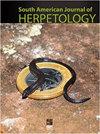银油漆树的颜色变异及生境利用
IF 0.7
4区 生物学
Q4 ZOOLOGY
引用次数: 1
摘要
摘要Liolaemus是南美洲特有的一个物种丰富的属,对bbbb200个物种中的大多数物种的生物学知之甚少。其中一种,L. silvai在沿海的阿塔卡马沙漠中很常见,并且是两性二态的。我们通过捕捉在地表活动的蜥蜴,研究了它们在颜色和体型上的表型变化,以及栖息地的利用。为了评估表型变异,我们根据每只蜥蜴的腹侧咽喉区域和腹侧身体从肩带到臀部的可见颜色,对它们的颜色形态进行了分类。我们还对每只蜥蜴进行了性别鉴定,测量了嘴巴长度和体重,并记录了尾巴断裂的发生率。在栖息地方面,我们测量了栖木的高度,从岩石边缘到最近植被的距离,以及最初发现蜥蜴的岩石的高度。我们通过将捕获的岩石与距离初始栖地随机方向最近的岩石配对,将栖地特征与栖息地中可用的特征进行比较,来评估栖息地选择。雄银银银的体型显著大于雌银银银银银,但颜色形态和断尾频率与性别无关。蜥蜴使用的岩石明显更接近植被,而不是环境中独立于性别或颜色变化的随机岩石。我们记录了同样的栖木高度模式。需要进一步的研究来检验植被对银银的确切作用。本文章由计算机程序翻译,如有差异,请以英文原文为准。
Color Variation and Habitat Use in Liolaemus silvai
Abstract. Liolaemus is a species-rich genus endemic to South America with relatively little known about the biology of most of the > 200 included species. One species, L. silvai is common in the coastal Atacama Desert and is sexually dimorphic. We studied their phenotypic variation in color and body size, as well as habitat use by capturing lizards active on the surface. To assess phenotypic variation, we categorized the color morph of each lizard based on visible coloration in their ventral throat region and their ventral body from the shoulder girdle to the hips. We also sexed each lizard, measured snout–vent length and body mass, and recorded incidences of tail breakage. For habitat use we measured perch height, distance from the rock edge to nearest vegetation, and the height of the rocks on which lizards were initially sighted. We assessed habitat selection by comparing perch characteristics to features available in the habitat by pairing capture rocks with the nearest rock in a random direction from the initial perch site. Male L. silvai were significantly larger than females, but color morph and tail break frequency were independent of sex. Lizards used rocks that were significantly closer to vegetation than random rocks available in the environment independently of sex or color morph. We document the same pattern for perch height. Future studies are needed to examine the exact role of vegetation for L. silvai.
求助全文
通过发布文献求助,成功后即可免费获取论文全文。
去求助
来源期刊
CiteScore
1.50
自引率
0.00%
发文量
10
期刊介绍:
The South American Journal of Herpetology (SAJH) is an international journal published by the Brazilian Society of Herpetology that aims to provide an effective medium of communication for the international herpetological community. SAJH publishes peer-reviewed original contributions on all subjects related to the biology of amphibians and reptiles, including descriptive, comparative, inferential, and experimental studies and taxa from anywhere in the world, as well as theoretical studies that explore principles and methods.

 求助内容:
求助内容: 应助结果提醒方式:
应助结果提醒方式:


